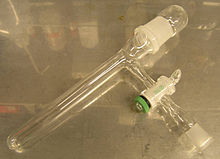Schlenk technique
The Schlenk technique is a chemical working process with which air- or moisture-sensitive substances can be processed with the exclusion of air, oxygen and humidity . It is named after the German chemist Wilhelm Schlenk (1879–1943).
method
Glass devices with standard ground joints are used, which have an additional connection with a tap, via which the apparatus can be vented, dried if necessary and charged with protective gas. Degassing (evacuation) is usually carried out using a rotary vane pump with upstream cold traps . As protective gases are nitrogen or argon is used. Nitrogen is cheaper than argon, but it reacts with some highly sensitive reagents (e.g. titanium organyls).
The Schlenk apparatuses are usually connected to a glass apparatus ( Schlenk line , vacuum inert gas line , nitrogen distribution screen ) via hoses , which, depending on the position of a special tap ( two-way patent tap or separate taps), vent the connected apparatus or use protective gas fills. As a rule, these glass apparatuses have several of these taps so that several apparatuses can be used at the same time or in parallel. The apparatus becomes empty, i.e. H. built without chemicals. All ground joints are secured, for example with the help of springs and ligatures. Then the hoses are connected.
One or more cold traps in front of the rotary vane pump are usually cooled with liquid nitrogen filled into Dewar flasks , the inert gas bottle is opened and the vacuum pump is switched on. What is known as “securing” takes place: The traces of air and water in a glass vessel are removed by alternating evacuation and letting the inert gas flow in. Moisture residues are removed very effectively by heating the equipment in the evacuated state from the outside, for example with a hot air blower or by flaming it with a burner flame. Alternatively, the glass devices can be baked out in a drying cabinet and put together while hot. The inert gas is then allowed to flow in. After appropriate preparation of the apparatus, the reagents are added.
During the entire course of the experiment, care must be taken that no air gets into the apparatus when a stopper or a sealed vessel is opened. If you have to open the apparatus to the laboratory environment, a slight overpressure of the protective gas can be applied to the vessel to be opened. The flow of inert gas directed outwards when the vessel is opened prevents the ingress of ambient air.
For higher demands or very complex tasks, the work can be carried out under protective gas in a so-called glove box. In particular, very toxic, radioactive or very oxygen-sensitive substances are handled in a glove box. Compared to Schlenk technology, however, this has the main disadvantage that the work is very time-consuming and must be very well prepared, since all equipment and substances have to be brought into and out of the glove box via locks. One advantage of the Schlenk technology is that you can work in a high vacuum with it.
See also
Web links
- Sella, Andrea: Schlenk Apparatus . In: Chemistry World . January 2008, p. 69. Retrieved January 30, 2008.
- Tidwell, Thomas: Wilhelm Schlenk: The Man Behind the Flask . In: Angewandte Chemie International Edition . 40, 2001, pp. 331-337. doi : 10.1002 / 1521-3773 (20010119) 40: 2 <331 :: AID-ANIE331> 3.0.CO; 2-E .
- Jürgen Heck: The Integrated Synthesis Course: Schlenk Technique (reprint at Norwegian University of Science and Technology; PDF; 5.3 MB) Universität Hamburg . Archived from the original on March 9, 2008. Retrieved February 11, 2011.
- Handling and Storage of Air-Sensitive Reagents (PDF; 3.2 MB) Sigma-Aldrich . Retrieved February 11, 2011.

